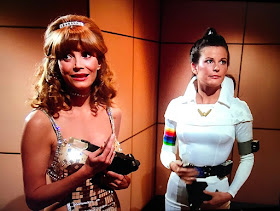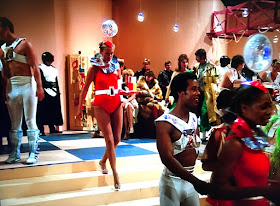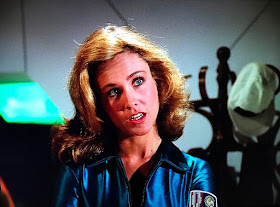


I genuinely had my doubts about Star Trek: Discovery (2017-present). I actually didn't have that much of an interest to be frank about it. I won't deny I wasn't just a little bit intrigued with Star Trek: Discovery in the hands of Bryan Fuller (Hannibal). Could it or would it come close to being as good as Star Trek: The Original Series (1966-1969) or at least Hannibal if we were to compare apples to oranges at least in terms of quality?

Obviously some prefer Star Trek: The Next Generation (1987-1994) even more, a seriously gloriously restored on Blu-ray. While others embraced the deviation from formula set by Star Trek: Deep Space Nine (1993-1999) and the likes of creative upstarts involved with it including Ronald D. Moore (Battlestar Galactica, Outlander). Star Trek: Voyager (1995-2001) had its own advocates (along with detractors; is anyone ever really happy even within the Star Trek universe?). Then there were those fans of Star Trek: Enterprise (2001-2005) seen as something like an odd duck stepchild, but that show too had its moments and an equally impressive cast.

And for all of the worlds that populate Star Trek, not unlike 007 and James Bond, there is a certain set of expectations, rules, a framework and perhaps, yes, even a formula to the franchise.
I wondered at this point in this writer's game if I even had an interest in another Star Trek variation within the longstanding franchise. Part of me seemed fatigued, maybe a bit bored by its output. That's sad to say I know.

Further, I have never been overly enthused by the films, particularly the action films established by J.J. Abrams. They are good action movies, but not particularly required viewing for a science fiction fan and especially those who loved the original Star Trek series. Again, it pains me to say, but they are just okay.
So I half expected Star Trek: Discovery to fail with Paramount/CBS falling squarely on its face by expecting membership to CBS All Access. I won't do it. I just can't. Again, as you know, I'm sort of casual about it all.

I recall having a similar reaction to Stargate Universe (2009-2011). I remember thinking it appeared too radically different and therefore unworthy of the Stargate moniker and franchise. In its first episode there was a big-breasted brunette being banged in a space closet. Normally this would be a good thing, but I was thrown. And I was wrong about Stargate Universe and I was too late to the party, as I suspect others were. It was cancelled before my enlightenment. It was a fascinating new endeavor for the franchise and arguably the best. In the end I loved Stargate Universe. I just couldn't have been more wrong about a sci-fi property.

At this point there have been some very different reactions to Star Trek: Discovery. So I offer my humble take here. With so little enthusiasm for Star Trek you can imagine my surprise when I actually enjoyed this new telling, new approach to the universe of Star Trek. Though the dynamic take on the mythology makes it relatively easy to see why fans of any of the previous Star Trek series might have problems with it. Not me. It was a refreshing journey into Trek. And Star Trek: Discovery energizes the franchise in a similar fashion to J.J. Abrams yet felt more intelligent through its scripting led by an equally dynamic cast.

In short, Star Trek: Discovery, Season One, blew me away. Warp factor 9.99. Indeed it offered a significant departure not only from formula but defied my expectations in every way. All involved were indeed boldly going with this franchise and creating a fresh, new, relatable canvas for an assortment of fascinating characters and storylines. It was fearlessly weaving Star Trek into a kind of complex, science fiction adventure story perhaps I had longed for.

This iteration of the franchise is not without its moral or philosophical center despite this entertainment either - an area the recent films often leave me vacant. This achievement rests squarely on the writing. The emotional core of the series rests firmly with Sonequa Martin-Green (The Walking Dead) as Michael Burnham, a revelation here, but the other characters are equally layered. Martin-Green is tremendous though.
There is a cinematic quality to the series certainly inspired by the Abrams films. Even the adventure aspects of the Star Wars (1977) effect seems in play. But there are also homages to such classic science fictions as Dino De Laurentiis' Flash Gordon (1980). The show has sound effects that pay tribute and return us to Star Trek: The Original Series. Thank you.

The opening theme by Jeff Russo is a sophisticated, modern yet classical tribute to the spirit of the original's opener immortalized by Alexander Courage.
There are monsters and wildly creative forms of organic propulsion. Love that sporedrive. Alternate universes. Klingons. There are unexpected dark twists and turns. There are equal parts character drama, suspense and action. There just are not enough good things to say about a series that is indeed Star Trek whilst feeling like something entirely different. It's understandable some Star Trek franchise fans might take issue or have been rankled by the results, but I hope most are endorsing this latest production with open arms and give it a chance and support, because it's wonderful. And this time, unlike Stargate Universe or Firefly (2002), I'm not late to the party.

This was one of the most engaging Star Trek variations I had ever experienced. I'm here to say I am happy I am on board the Discovery and look forward to experiencing Season Two, because this show felt like an experience when I watched it on Blu-Ray.
It is an exceptional series beyond science fiction --- absolutely brilliant. I had no idea anyone would have had the balls to reinvent the franchise in such a vainglorious and original fashion. Stunning. Star Trek: Discovery is some of the most riveting serialized outer space science fiction I've seen in some time. The level of actual dramatic engagement is on par with the kind of television that made the reinvigorated, reimagined Battlestar Galactica (2003-2009) so magnetic for me.

To put this in some perspective, in recent years, The Expanse (2015-present), now moving into its fourth season, and based on the literature of James S.A. Corey has maintained the mantle of superior, smart, science fiction storytelling. Star Trek: Discovery may in fact best that series in some ways or at the very least match it on a narrative level, while retaining the kind of character energy that infused the Ronald D. Moore Galactica, and that's really saying something. It's that damn good. I've yet to invest in Season Two and I'm thrilled there are more seasons to come. This writer hopes the series does indeed live long and prosper. This is one of the greats at the moment. Who knew a franchise begun in 1966 could still have so much to offer.

I have had difficulty finding quality series with which to engage. Hell, I'm re-watching HBO's The Wire (2002-2008). But I am humbled to say I could not have been more wrong and more surprised at the results on display for this new Star Trek. I would easily watch this again too. While incredibly ambitious, at times dark, there is a twinkle in the eye of this one. Excited for the future, I am indeed a convert and this from someone who ranks Star Trek: The Original Series at the top.
At some point maybe I will take a closer look because this one is a keeper, but for now...Wow! This was indeed an unexpected discovery.
The kind of background character you're just itching to know a little more about.






























































